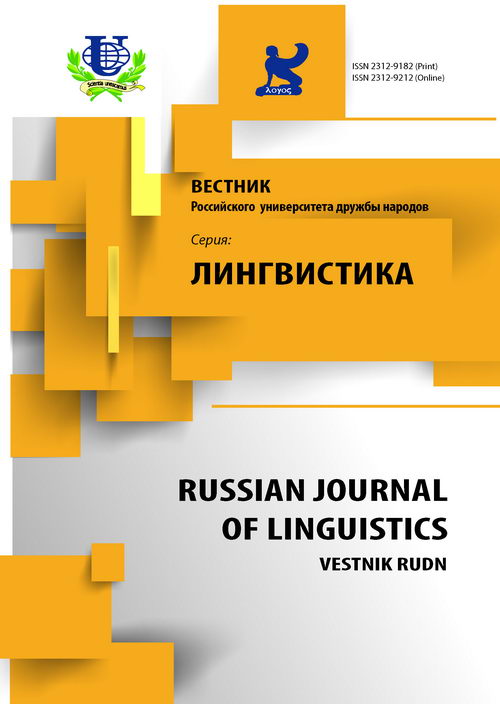Выражение эмоций грамматическими средствами английского языка
- Авторы: Озюменко В.И.1
-
Учреждения:
- Российский университет дружбы народов
- Выпуск: № 1 (2015)
- Страницы: 126-143
- Раздел: Статьи
- URL: https://journals.rudn.ru/linguistics/article/view/9409
Цитировать
Полный текст
Аннотация
Национально-культурные особенности проявления эмоций и средства их выражения в различных лингвокультурах вызывают в последнее время большой интерес исследователей. Однако при изучении эмоций основное внимание, как правило, уделяется лексико-фразеологическим и просодическим средствам языка, а также знакам невербальной коммуникации. Грамматические средства при этом часто выпадают из поля зрения исследователей, хотя они также обладают эмотивным потенциалом - могут передавать различные эмоции говорящего и оказывать определенное эмоциональное воздействие на собеседника. Цель данной статьи - раскрыть данный тезис на примере английского языка и показать необходимость учета грамматических средств выражения эмоций. Обнаружение и распознавание эмотивной импликатуры, т.е. имплицитного эмотивного содержания, которое закодировано в высказывании говорящего, является необходимым условием успешной межкультурной коммуникации и эквивалентного перевода. В статье будут обобщены и систематизированы ранее описанные факты (Озюменко 2005-2006, 2007), которые будут дополнены новыми наблюдениями. В центре внимания - модальные глаголы и выражения, нетрадиционное употребление глагольно-временных форм и наречий, инверсивный порядок слов и др. Материалом исследования послужили учебники английского языка, книги по грамматике, словари, тексты художественных произведений. Полученные данные были подвергнуты контекстуальному, дефинитивному, прагматическому, дискурсивному, лингвокультурологическому и сопоставительному анализу.
Ключевые слова
Об авторах
Владимир Иванович Озюменко
Российский университет дружбы народов
Email: vladimir@ozyumenko.ru
Кафедра иностранных языков юридического факультета
Список литературы
- Виноградов В.В. О категории модальности и модальных словах в русском языке // Избр. тр.: Исслед. по рус. грамматике. М., 1975. Т. 2. С. 38-79.
- Джиоева О.А. Англосаксонский менталитет сквозь призму английского языка. М.: Издательство Московского университета, 2014.
- Ирисханова О.К. Игры фокуса в языке. Семантика, синтаксис и прагматика дефокусирования. М.: ЯСЛ, 2014.
- Красавский Н.А. Эмоциональные концепты в немецкой и русской лингвокультурах. Волгоград: Издательство «Перемена», 2001.
- Ларина Т.В. Выражение эмоций в английской и русской коммуникативных культурах // Язык и эмоции: личностные смыслы и доминанты в речевой деятельности: Сб. научных трудов. Волгоград: Издательство ЦОП «Центр», 2004. С. 36-46.
- Ларина Т.В. A smile opens many doors: эмоции в коммуникации и переводе // Мосты. Журнал переводчиков. 2006. № 4 (12). С. 50-55.
- Ларина Т.В. Категория вежливости и стиль коммуникации: сопоставление английских и русских лингвокультурных традиций. М.: Языки славянских культур, 2009.
- Озюменко B.И. Грамматическое выражение эмоций в английском языке // Вестник РУДН. Серия «Русский и иностранные языки и методика их преподавания». 2005-2006. № 1(3-4). С. 172-180.
- Озюменко B.И. Модальность и эмоции в английском языке // Вестник РУДН. Серия «Русский и иностранные языки и методика их преподавания». 2007. № 3. С. 92-98.
- Пешковский А.М. Русский синтаксис в научном освещении. 7-е изд. М., 1956.
- Филимонова О.Е. Язык эмоций в английском тексте (когнитивный и коммуникативный аспекты). СПб.: Издательство РГПУ им. А.И. Герцена, 2001.
- Шаховский В.И. Категоризация эмоций в лексико-семантической системе языка. Воронеж: Воронеж. гос. ун-т, 1987.
- Шаховский В.И. Лингвистическая теория эмоций. М.: Гнозис, 2008.
- Шаховский В.И., Карасик В.И. Эмотивность и модальность в семантике слова // Семантика слова и синтаксической конструкции: Сб. науч. тр. Воронеж: Изд-во Воронеж. ун-та, 1987. С. 31-38.
- Эмотивная лингвоэкология в современном коммуникативном пространстве: кол. монография. Волгоград: Издательство ВГСПУ «Перемена», 2013.
- Язык и эмоции: личностные смыслы и доминанты в речевой деятельности. Сб. научных трудов. Волгоград: Изд-во ЦОП «Центр», 2004.
- Alexander L.G. Longman English Grammar. Longman Group UK Ltd., 1988.
- Alexander L.G. Longman Advanced Grammar. Longman Group UK Ltd., 1993.
- Brown Penelope and Stephen D. Levinson. Politeness: Some universals in language usage. Cambridge: Cambridge University Press, 1987.
- Baker A. Ship or Sheep: An intermediate pronunciation course. Cambridge University Press, 1981.
- Fox K. Watching the English. The Hidden Rules of English Behaviour. London: Hodder, 2005.
- Hewings M. Advanced Grammar in Use. Cambridge University Press, 1999.
- Leech G., Larina T. Politeness: West and East // Bulletin of the Peoples’ Friendship University of Russia: Linguistics. 2014, N 4. P. 9-34.
- Murthy Raymond. English Grammar in Use: A self-study reference and practice book for intermediate students. Second edition. Cambridge University Press, 2003.
- Pavlenko A. Emotions and the body in Russian and English / Pragmatics & Cognition 10:1/2 (2002), John Benjamins Publishing Company. P. 207-241.
- Pavlenko A. Emotions and Multilingualism. Cambridge University Press, 2007.
- Soars, Liz and John. New Headway English Course: Upper intermediate. Student’s book. Oxford University Press, 1998.
- Wierzbicka A. Emotion, language and cultural scripts // S. Kitayama and H. Markus (eds.). Emotion and Culture. Washington: American Psychological Association, 1994. P. 130-198.
- Wierzbicka A. Emotions across Languages and Cultures: Diversity and Universality. Cambridge: Cambridge University Press, 1999.
- Wierzbicka A. Cross-Cultural Pragmatics. The Semantics of Human Interaction. Second edition. Mouton de Gruyter, 2003.

















